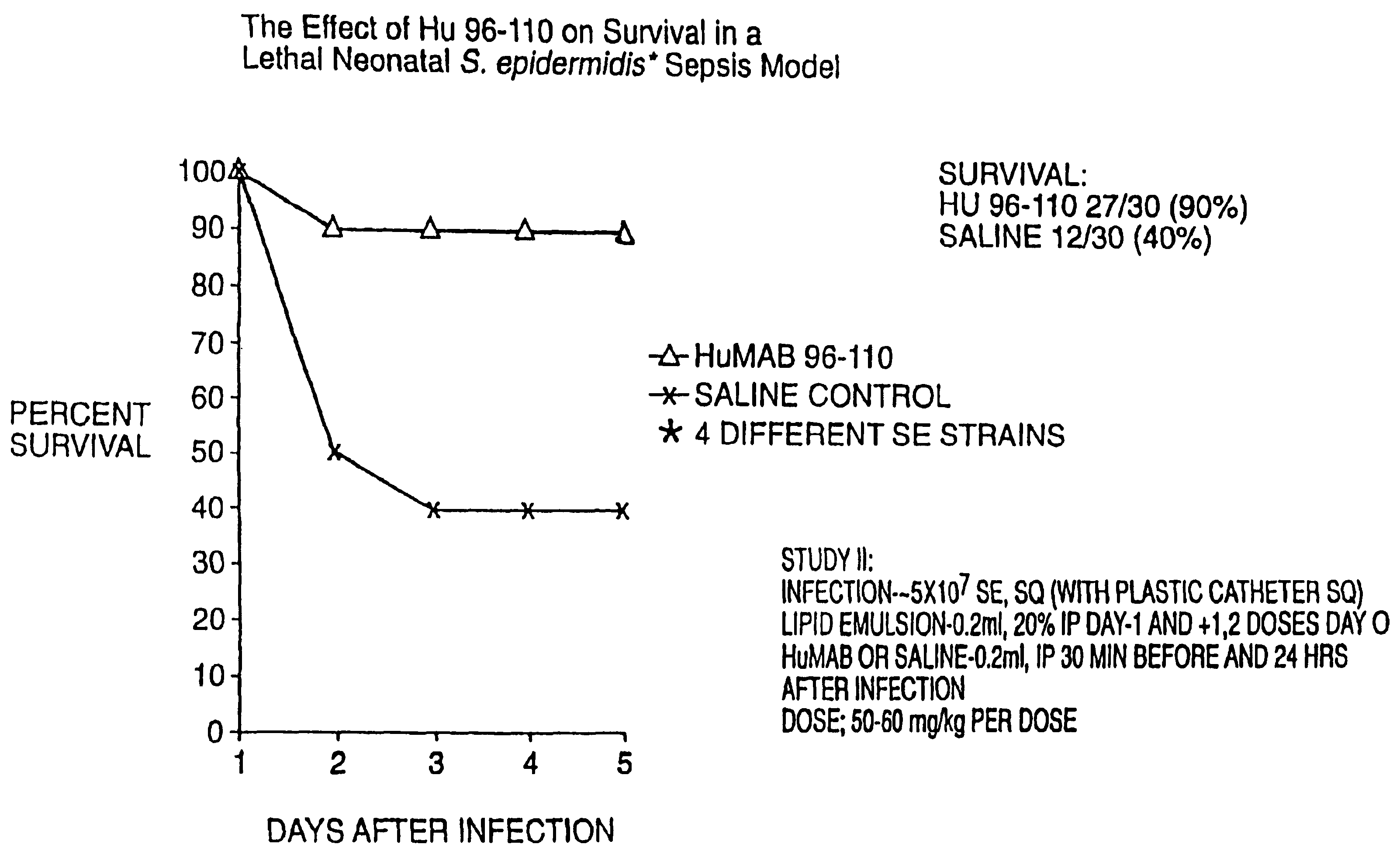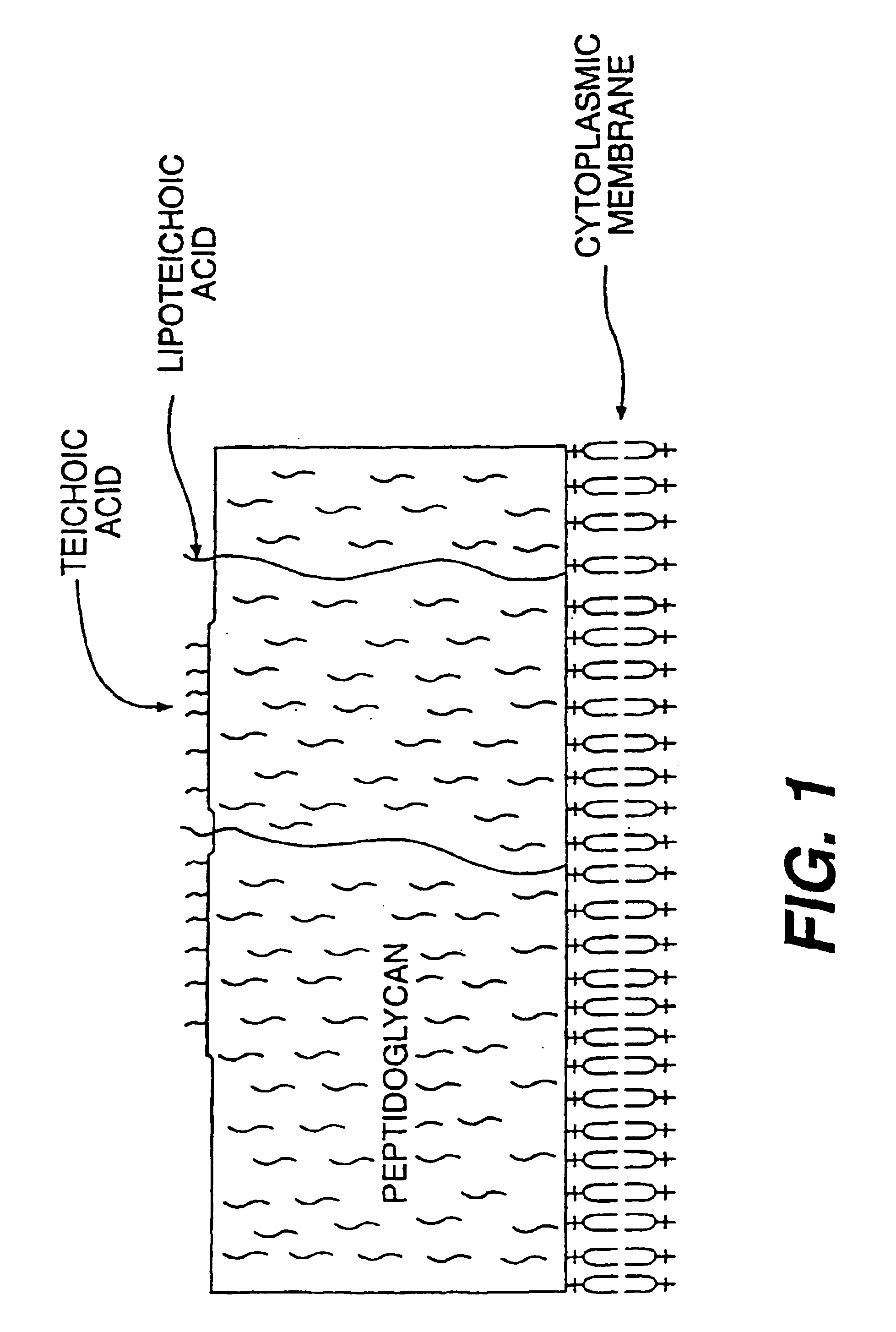Opsonic and protective monoclonal and chimeric antibodies specific for lipoteichoic acid of gram positive bacteria
a technology of lipoteichoic acid and gram positive bacteria, applied in the field of immunology and infectious diseases, can solve the problems of human morbidity and mortality, battle has not been won, and the death of a bacterial infection is often rapid and inevitable, so as to enhance the phagocytosis and kill bacteria, and enhance the protection from lethal infection
- Summary
- Abstract
- Description
- Claims
- Application Information
AI Technical Summary
Benefits of technology
Problems solved by technology
Method used
Image
Examples
example 1
The Production of Hybridomas and Monoclonal Antibodies
[0106]To produce monoclonal antibodies that were directed against the surface proteins of S. epidermidis and were opsonic and protective for S. epidermidis, mice were immunized with whole S. epidermidis, Strain Hay.
[0107]A suspension of heat killed S. epidermidis was adjusted to an optical density (OD) of 0.137 at a wavelength of 650 nm when measured through a 1 centimeter light path. Bacteria from five mls of the suspension were pelleted by centrifugation (approximately 1800×g, 10 minutes, room temperature). The supernatant was discarded and the pellet resuspended in 0.6 mls of PBS, which was then mixed with 0.9 mls of complete Freund's adjuvant (CFA). The resulting emulsion was used as the immunogen.
[0108]Adult, female BALB / c mice, obtained from Harlan Sprague Dawley (Indianapolis, Ind.) were immunized subcutaneously with 0.2 mls of the immunogen described above. The mice received a booster immunization approximately two and ½ ...
example 2
The Opsonic Activity of the Monoclonal Antibody
[0124]Antibodies which bind to an antigen may not necessarily enhance opsonization or enhance protection from infection. Therefore, a neutrophil mediated bactericidal assay was used to determine the functional activity of antibody to S. epidermidis. Neutrophils were isolated from adult venous blood by dextran sedimentation and ficoll-hypaque density centrifugation. Washed neutrophils were added to round-bottomed wells of microtiter plates (approximately 106 cells per well) with approximately 3×104 mid-log phase bacteria (S. epidermidis Hay, ATCC 55133). Newborn lamb serum (10 uls), screened to assure absence of antibody to S. epidermidis, was used as a source of active complement.
[0125]Forty microliters of immunoglobulin (or serum) were added at various dilutions and the plates were incubated at 37° C. with constant, vigorous shaking. Samples of 10 uls were taken from each well at zero time and after 2 hours of incubation. Each was dilu...
example 3
[0129]Opsonic antibody correlates with enhanced protection from staphylococcal infections, as set forth in the recent series of Fischer applications and issued patent described and incorporated by reference above. To further demonstrate that the MAB can enhance survival to infections with both coagulase positive and coagulase negative Staphylococci, studies were conducted using lethal infection models.
[0130]Two day old Wistar rats were injected with −106 S. aureus (type 5, ATCC 12605) subcutaneously just cephalad to the tail. Approximately 30 minutes before and 24 and 48 hours after infection, 0.2 ml MAB 96-110 (˜320 ug) was given IP. Control animals were given an equal volume of saline or a control MAB not directed against Staphylococci. All animals were observed daily for five days to determine survival.
[0131]MAB 96-110 enhanced survival in this lethal neonatal model of coagulase positive staphylococcus sepsis (FIG. 3): 8 / 15 survived after treatment with...
PUM
| Property | Measurement | Unit |
|---|---|---|
| concentrations | aaaaa | aaaaa |
| OD | aaaaa | aaaaa |
| time | aaaaa | aaaaa |
Abstract
Description
Claims
Application Information
 Login to View More
Login to View More - R&D
- Intellectual Property
- Life Sciences
- Materials
- Tech Scout
- Unparalleled Data Quality
- Higher Quality Content
- 60% Fewer Hallucinations
Browse by: Latest US Patents, China's latest patents, Technical Efficacy Thesaurus, Application Domain, Technology Topic, Popular Technical Reports.
© 2025 PatSnap. All rights reserved.Legal|Privacy policy|Modern Slavery Act Transparency Statement|Sitemap|About US| Contact US: help@patsnap.com



